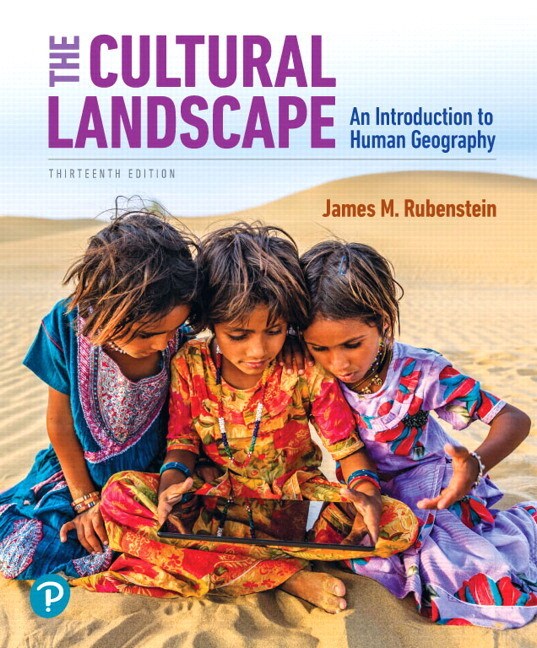
Cultural Landscape, The: An Introduction to Human Geography, 13th edition
- James M. Rubenstein

- Study simpler and faster
Use flashcards and other study tools in your eTextbook
- Listen on the go
Learn how you like with full eTextbook audio
- Find it fast
Quickly navigate your eTextbook with search
- Stay organized
Access all your eTextbooks in one place
- Easily continue access
Keep learning with auto-renew
The Cultural Landscape: An Introduction to Human Geography uses a structured learning path to explore the patterns and processes of Earth’s human landscapes. Rubenstein weaves themes such as globalization throughout the text, with a clear, engaging organization and presentation.
The 13th Edition incorporates the latest data and applied examples of human geography. It helps you connect global concepts and phenomena to your local geography, while engaging you in active debate around essential topics of human geography.
Published by Pearson (May 23rd 2019) - Copyright © 2020
ISBN-13: 9780135729625
Subject: Geography
Category: Human Geography
1. This Is Geography
- 1.1 Why Is Geography a Science?
- 1.2 Why Is Every Place Unique?
- 1.3 Why Are Different Places Similar?
- 1.4 Why Are Some Actions Not Sustainable?
2. Population & Health
- 2.1 Where Are People Distributed?
- 2.2 Why is Population Increasing?
- 2.3 Why Does Health Vary by Region?
- 2.4 Why Might Population Change in the Future?
3. Migration
- 3.1 Where Are Migrants Distributed?
- 3.2 Where Do People Migrate Within Countries?
- 3.3 Why Do People Migrate?
- 3.4 Why Do Migrants Face Challenges?
4. Culture & Social Media
- 4.1 Where Are Culture Groups Distributed?
- 4.2 Where Are Leisure & Material Culture Distributed?
- 4.3 Why Is Access to Culture Unequal?
- 4.4 Why Do Cultures Face Sustainability Challenges?
5. Languages
- 5.1 Where Are Languages Distributed?
- 5.2 Why Do Languages Diffuse?
- 5.3 Why Do Languages Vary Among Places?
- 5.4 Why Do Languages Survive or Perish?
6. Religions
- 6.1 Where Are Religions Distributed?
- 6.2 Why Do Religions Have Distinctive Distributions?
- 6.3 Why Do Religions Organize Space in Specific Patterns?
- 6.4 Why Do Territorial Conflicts Arise Among Religious Groups?
7. Ethnicities
- 7.1 Where Are Ethnicities Distributed?
- 7.2 Why Do Ethnicities Have Distinctive Distributions?
- 7.3 Why Might Ethnicities Face Conflicts?
- 7.4 Why Do Ethnic Cleansing & Genocide Occur?
8. Political Geography
- 8.1 Where Are States Distributed?
- 8.2 Why Are States Challenging to Create?
- 8.3 Why Do States Face Threats?
- 8.4 Why Do States Have Distinctive Geographic Structure?
9. Food & Agriculture
- 9.1 Why Do People Consume Different Foods?
- 9.2 Where Did Agriculture Originate?
- 9.3 Where Is Agriculture Distributed?
- 9.4 Why Do Farmers Face Sustainability Challenges?
10. Development
- 10.1 Why Does Development Vary Among Countries?
- 10.2 Where Are Inequalities in Development Distributed?
- 10.3 Why Do Countries Face Development Challenges?
- 10.4 Why Are Countries Able to Make Progress in Development?
11. Industry & Energy
- 11.1 Where Is Industry Distributed?
- 11.2 Why Do Industries Face Energy Challenges?
- 11.3 Why Do Industries Face Pollution Challenges?
- 11.4 Why Are Industries Changing Locations?
12. Services & Settlements
- 12.1 Where Are Services Distributed?
- 12.2 Where Are Consumer Services Distributed?
- 12.3 Where Are Business Services Distributed?
- 12.4 Why Do Services Cluster in Settlements?
13. Urban Patterns
- 13.1 Why Are Cities Challenging to Define?
- 13.2 Where Are People Distributed in Urban Areas?
- 13.3 Why Do Urban Areas Expand?
- 13.4 Why Might Cities Be More Sustainable?
- Summary & Review
- Afterword: Careers in Geography
- Appendix: Map Scale and Projections
- Glossary
- Credits
- Map Index